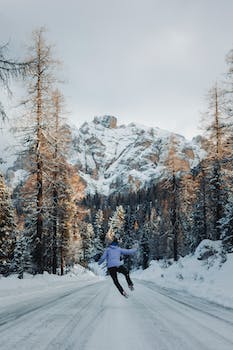

-
Table of Contents
Unveiling the Radiance: Discover the Hidden Beauty of the Golden Hour
Introduction
The golden hour, also known as the magic hour, refers to the period shortly after sunrise or before sunset when the sun is low in the sky, casting a warm and soft light. This time of day is highly regarded by photographers and artists for its enchanting and ethereal qualities. During the golden hour, the light is diffused, creating long shadows, vibrant colors, and a captivating atmosphere. It is a time when the world seems to glow, revealing the hidden beauty of landscapes, architecture, and even people. In this article, we will delve into the mesmerizing allure of the golden hour and explore how it can enhance our appreciation of the world around us.
Capturing the Serene Magic: Photographing the Golden Hour
The golden hour, also known as the magic hour, is a period of time shortly after sunrise or before sunset when the light is soft, warm, and diffused. It is a photographer's dream, offering a unique and enchanting quality of light that can transform ordinary scenes into extraordinary works of art. In this article, we will explore the hidden beauty of the golden hour and discuss how to capture its serene magic through photography.
One of the most captivating aspects of the golden hour is the warm, golden light that bathes the landscape. During this time, the sun is low on the horizon, and its rays have to pass through more of the Earth's atmosphere, resulting in a soft, diffused light that casts a warm glow on everything it touches. This warm light can add a sense of depth and dimension to your photographs, creating a magical and ethereal atmosphere.
Another characteristic of the golden hour is the long shadows it creates. As the sun is positioned at a low angle, it casts long, dramatic shadows that can add interest and depth to your images. These shadows can create a sense of mystery and intrigue, drawing the viewer's eye into the scene and adding a dynamic element to your composition.
In addition to the warm light and long shadows, the golden hour also offers a wide range of colors. The sky often takes on a beautiful palette of warm oranges, pinks, and purples, creating a stunning backdrop for your photographs. These vibrant colors can add a sense of drama and beauty to your images, making them visually striking and captivating.
To capture the serene magic of the golden hour, it is important to plan your shoot in advance. Check the weather forecast and find out the exact time of sunrise or sunset in your location. Arrive early to scout the area and find the best vantage points for your photographs. Consider the direction of the light and how it will interact with your subject. Experiment with different angles and compositions to create visually compelling images.
When photographing during the golden hour, it is crucial to pay attention to your exposure. The soft, diffused light can be challenging to meter correctly, so it is recommended to use manual mode and adjust your settings accordingly. Start by setting your ISO to the lowest possible value to minimize noise in your images. Then, choose a wide aperture to create a shallow depth of field and make your subject stand out. Finally, adjust your shutter speed to achieve the desired exposure, keeping in mind that longer exposures can create beautiful motion blur in moving subjects.
In conclusion, the golden hour is a magical time for photographers to capture the hidden beauty of the world. Its warm, diffused light, long shadows, and vibrant colors can transform ordinary scenes into extraordinary works of art. By planning your shoot in advance, paying attention to your exposure, and experimenting with different angles and compositions, you can capture the serene magic of the golden hour and create stunning photographs that will leave a lasting impression on viewers. So, grab your camera and venture out during the golden hour to explore the hidden beauty that awaits.
Unveiling Nature's Masterpiece: Exploring the Golden Hour in Landscapes

Exploring the Hidden Beauty of the Golden Hour
The Golden Hour, also known as the Magic Hour, is a period of time shortly after sunrise or before sunset when the light is soft, warm, and diffused. It is a time when photographers and nature enthusiasts alike flock to capture the stunning beauty that unfolds during this magical time of day. In this article, we will delve into the hidden beauty of the Golden Hour, specifically in landscapes, and uncover the secrets that make it nature's masterpiece.
During the Golden Hour, the sun is positioned low in the sky, casting a warm, golden glow over the landscape. This soft, diffused light creates a sense of tranquility and adds a touch of magic to any scene. The colors become more vibrant, with hues of orange, pink, and gold painting the sky and reflecting off the surrounding elements. It is a time when nature seems to come alive, as if it is putting on a show just for us.
One of the most captivating aspects of the Golden Hour is the way it transforms the landscape. The soft light enhances the textures and details of the natural elements, bringing out their true beauty. The gentle shadows and highlights create depth and dimension, adding a sense of drama to the scene. Whether it is a field of wildflowers, a majestic mountain range, or a serene lake, the Golden Hour has the power to elevate any landscape into a work of art.
Photographers often refer to the Golden Hour as the "magic hour" for a reason. The quality of light during this time is simply unparalleled. It is softer and more flattering, making it ideal for capturing stunning photographs. The warm tones and long shadows create a sense of depth and mood, adding an ethereal quality to the images. It is a time when even the most ordinary scenes can be transformed into extraordinary works of art.
But the Golden Hour is not just about capturing beautiful photographs; it is also about experiencing the beauty of nature firsthand. It is a time when the world seems to slow down, allowing us to appreciate the small details that often go unnoticed. The gentle breeze, the chirping of birds, and the rustling of leaves create a symphony of sounds that adds to the overall sensory experience. It is a time to connect with nature and find solace in its beauty.
In addition to its aesthetic appeal, the Golden Hour also has practical benefits for landscape photography. The soft, diffused light reduces harsh shadows and eliminates the need for artificial lighting or flash. This makes it easier to capture well-exposed images with a balanced range of tones. The warm tones also add a sense of warmth and intimacy to the photographs, evoking a feeling of nostalgia and serenity.
In conclusion, the Golden Hour is a truly magical time of day that unveils nature's masterpiece in landscapes. Its soft, warm light transforms ordinary scenes into extraordinary works of art, capturing the beauty and essence of the natural world. Whether you are a photographer looking to capture stunning images or simply a nature enthusiast seeking solace in the beauty of the world, the Golden Hour is an experience that should not be missed. So, next time you find yourself awake before sunrise or lingering after sunset, take a moment to embrace the hidden beauty of the Golden Hour and let nature's masterpiece unfold before your eyes.
Enhancing Portraits with Radiant Glow: Unveiling the Golden Hour's Beauty
The golden hour, that magical time just after sunrise or before sunset, has long been revered by photographers for its soft, warm light and stunning colors. But the beauty of the golden hour extends beyond landscapes and seascapes. It can also enhance portraits, adding a radiant glow to the subject and creating a truly captivating image.
One of the key reasons why the golden hour is so ideal for portrait photography is the quality of light it provides. During this time, the sun is low in the sky, which means the light is diffused and less harsh. This soft, gentle light is incredibly flattering for portraits, as it minimizes shadows and creates a natural, even illumination on the subject's face.
The warm, golden tones of the light during the golden hour also add a touch of magic to portraits. The soft, warm hues can create a sense of warmth and intimacy in the image, making the subject appear more inviting and approachable. This can be particularly beneficial for capturing candid moments or creating a sense of connection between the subject and the viewer.
In addition to the quality of light, the golden hour also offers unique opportunities for creative composition. The long shadows and warm tones can be used to create interesting patterns and textures in the background, adding depth and visual interest to the image. By positioning the subject in relation to these elements, photographers can create a sense of balance and harmony in the composition.
To make the most of the golden hour for portrait photography, it's important to plan ahead and be prepared. Since the golden hour is a relatively short window of time, it's crucial to arrive at the location early and set up your equipment in advance. This will give you ample time to find the perfect spot, adjust your camera settings, and make any necessary adjustments to the lighting.
When it comes to camera settings, shooting in manual mode is often recommended during the golden hour. This allows you to have full control over the exposure, aperture, and shutter speed, ensuring that you capture the desired effect. It's also important to pay attention to the white balance, as the warm tones of the golden hour can sometimes result in a color cast. Adjusting the white balance settings or shooting in RAW format can help you achieve accurate and natural-looking colors.
In terms of posing and directing the subject, it's important to keep in mind the mood and atmosphere you want to convey in the image. The soft, warm light of the golden hour lends itself well to natural and relaxed poses, as well as capturing genuine emotions and expressions. Encouraging the subject to interact with their surroundings or engage in an activity can also add a sense of authenticity and storytelling to the image.
In conclusion, the golden hour is a truly magical time for portrait photography. The soft, warm light and stunning colors can enhance the beauty of the subject, creating a radiant glow and captivating image. By understanding the qualities of light, planning ahead, and making the necessary adjustments, photographers can make the most of this golden opportunity and capture truly breathtaking portraits. So next time you're out with your camera, don't forget to explore the hidden beauty of the golden hour.
Q&A
1. What is the golden hour?
The golden hour refers to the period shortly after sunrise or before sunset when the sunlight is softer, warmer, and more diffused, creating a beautiful golden glow.
2. Why is the golden hour considered the best time for photography?
During the golden hour, the lighting conditions are ideal for photography as the soft, warm light enhances colors, adds depth and dimension to subjects, and creates a magical atmosphere.
3. How can one explore the hidden beauty of the golden hour?
To explore the hidden beauty of the golden hour, one can venture outdoors during sunrise or sunset, experiment with different compositions, capture silhouettes, play with shadows and highlights, and take advantage of the unique lighting to create stunning photographs.
Conclusion
In conclusion, exploring the hidden beauty of the Golden Hour offers a unique and captivating experience. The soft, warm light during this time of day enhances the natural beauty of landscapes, architecture, and even people. It provides photographers and artists with a magical opportunity to capture stunning images and create breathtaking artwork. Whether it's witnessing a vibrant sunset or admiring the gentle glow of dawn, the Golden Hour never fails to inspire and evoke a sense of awe. It is a time worth exploring and appreciating for its hidden beauty.












